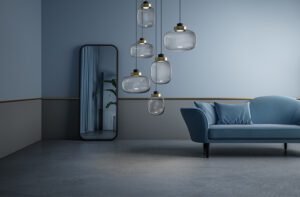High design meets high tech in a chic Boston condo
March 27, 2019
Text by Bob Curley Photography by Nat Rea
If decluttering guru Marie Kondo ever wants to create a dream house, she could turn to this Rina Okawa-designed condo in Boston for inspiration.
Downsizing from a spacious home in the suburbs to an in-town apartment—even one with 3,500 square feet of living space—is a challenge under any circumstances. But Okawa’s clients didn’t just want an open layout with strong design elements and the latest in convenience gadgets; they also wanted every hint of clutter banished behind closet and cabinet doors. And, despite the insistence on keeping things tidy, they also desired a sense of warmth. “The original unit had a basic contemporary design with sleek lines, but they felt that it was too cold,” says Okawa, senior interior designer at ZEN Associates. “They wanted some softness.”
The project began with some demolition intended to create more open spaces, including taking down a wall between the kitchen and dining room and combining two bedrooms to create a master suite with a dressing room and Japanese-inspired soaking room. The latter centers on an oversize freestanding tub, specially sourced to accommodate the man’s six-foot-three-inch frame.
The geometric lines of the eighteen-year-old condo remain, but Okawa introduced a variety of natural materials to provide warmth. Selective use of stone, such as in the foyer and kitchen, enhances the sense of welcome and serenity.
The consistent use of walnut, in particular, provides thematic unity from room to room. “That’s not so unusual for us,” explains Okawa. “We sometimes design concepts for each room, but we like to have a very strong vision throughout the space.”
All of the millwork features grain patterns carefully chosen to complement adjoining furnishings. “The idea is that they speak to each other,” says Woodmeister’s Sean Reynolds.
The kitchen is a model of efficiency; the clients love to cook, but there’s nary a spoon out of place. Cabinets conceal appliances, and even the power outlets pop back into walnut-covered alcoves when not in use. With the reconstruction, the cooking area now flows across a marble-topped island into the dining area, which sits in front of knee-to-ceiling windows with sweeping views of the Boston skyline and harbor.
A potentially wasted narrow space between the dining area and den is cleverly purposed as a wine cellar, with twin chairs facing the windows for after-work cocktails with a million-dollar view. Cove ceilings help define each space—living room, dining room, and seating area—arrayed before the windows, which have automatic shades and frames repainted from the original green to dark bronze to complement the Okawa design. An inviting leather sofa and armchairs serve to soften the edges of the living room—a function similarly performed by the leather-clad stools at the kitchen counter as well as the Molteni chairs circling the dining room table and the paired Maxalto Febo armchairs facing the Boston cityscape.
The shared Japanese heritage of designer and client is evident in the tatami room–inspired walnut space dividers and the flower-filled shelf that welcomes visitors in the foyer, reminiscent of traditional tokonoma. Such discreet displays aside, however, what you don’t see upon entering the home are wires, appliances, TVs, or even light switches or power outlets. Okawa, Woodmeister, and home automation firm System 7 collaborated to ensure that all the technology is “a touch away . . . but not in your face,” says Ashley Jacobson, director of operations at System 7.
Everything from lighting to shades to the tilting recliners is controlled from an iPad. Toilets open, close, and flush automatically. Every TV in the house is hidden: the flat-screen in the living room rises up from a cabinet built flush to the wall, while the one in the master bedroom lowers from the ceiling. “The client is crazy about high-tech gadgets,” Okawa says.
In the soaking room, the TV screen slumbers behind a mirror. Wall thermostats have been replaced by small “eyeball”-type sensors, with the master controls similarly secreted behind a mirror in the foyer.
Guests to this fastidiously maintained home are requested to remove their shoes, which predictably find their own spot in a dedicated cabinet beside the door. Even umbrellas are folded neatly away in their own secluded space.
Okawa concedes that it was a challenge to incorporate so much technology and still keep the space feeling serene, but the results speak—very quietly—for themselves.
Project Team
Interior design: Rina Okawa, ZEN Associates
Builder: Woodmeister Master Builders
Share
![NEH-Logo_Black[1] NEH-Logo_Black[1]](https://b2915716.smushcdn.com/2915716/wp-content/uploads/2022/08/NEH-Logo_Black1-300x162.jpg?lossy=1&strip=1&webp=1)

















You must be logged in to post a comment.